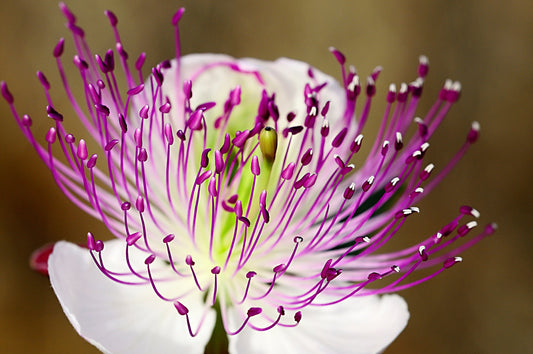



Free Shipping
Safe & Secure Payments
The Caper Bush (Capparis spinosa) is a hardy, drought-tolerant shrub that produces the famous edible capers. Known for its fragrant white or pinkish flowers and distinctive green, thorny stems, this plant is highly valued for its buds, which are harvested and pickled to make capers, a popular ingredient in Mediterranean and Middle Eastern cuisine. The caper bush thrives in sunny, dry environments and requires little maintenance, making it an excellent addition to herb gardens or landscapes. With 20 seeds in this pack, gardeners can cultivate their own caper bushes and enjoy a fresh, home-grown supply of capers.
Key Features:
Growing Information:
Light:
Caper bushes require full sun to grow properly. Aim for at least 6-8 hours of direct sunlight daily for optimal growth and flower production.
Soil:
These shrubs thrive in well-drained, poor to moderately fertile soils. Caper bushes are particularly tolerant of dry, rocky soils and can grow in areas with low organic matter. A slightly alkaline soil pH is ideal (between 7.0 and 8.0).
Planting Tips:
Start seeds indoors 4-6 weeks before the last frost date or sow directly outdoors once the danger of frost has passed and the soil has warmed. Soak the seeds in warm water for 24 hours before planting to improve germination. Plant seeds about 1/4 inch deep in the soil, and space them 18-24 inches apart. Caper bushes have a spreading habit, so give them enough room to grow.
Watering:
Caper bushes are drought-tolerant once established, but they should be watered regularly during their first growing season to help establish strong roots. After that, they only need occasional watering during dry periods. Be careful not to overwater, as caper bushes are susceptible to root rot in overly moist soils.
Temperature:
Caper bushes thrive in hot, dry conditions. They are well-suited for USDA Zones 8-11, where the temperatures remain warm and there is little frost. While they are hardy, they should be protected from freezing temperatures, as they can be damaged by frost.
Pruning:
Prune caper bushes in early spring before new growth begins to remove any dead or damaged wood. Cutting back the shrub can also encourage better air circulation and flower production. Regular pruning helps maintain the bush's shape and size.
Benefits:
Growing Zones:
Caper bushes thrive in USDA Zones 8-11, where temperatures remain warm throughout the year. They can tolerate some cold but should be protected from freezing conditions during winter months. Ideal for Mediterranean climates, hot, dry summers, and mild winters.
How to Use in the Garden:
Conclusion:
The Caper Bush (Capparis spinosa) is a versatile and valuable plant for any garden, offering both ornamental beauty and practical benefits. With its drought-tolerant nature, attractive flowers, and edible caper buds, it is an excellent choice for gardeners seeking to grow their own flavorful capers for cooking. Additionally, it thrives in hot, dry climates and requires minimal care once established, making it ideal for low-maintenance gardens. With 20 seeds in this pack, you’ll have the opportunity to cultivate this unique shrub and enjoy fresh, homegrown capers year after year.
Scegli le opzioni

